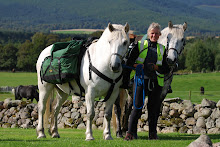
Bill told me this once, and I believe this saying comes from the world of National Hunt racing, where you have to learn quickly to survive!
I am always open to advice (I hope). NOT FROM ME, YOU'RE NOT - DOOGS. Stalkers are invaluable for this: not only do they know their ground intimately, they are up to date with the latest weather and river conditions.
I do have to factor in that they are usually braver, tougher and-alas- often younger than me; so "you'll get through there no bother" may not mean exactly what it says!
The other difficulty is that all too often potential problems come well into the day, so you've already covered 20 miles or so before you discover that the river is, in fact, impassable. This is one of the reasons I like a packhorse, so if the need arises I can camp and hope water levels drop significantly overnight, as they will often do (provided it's stopped raining, of course.)
Having spoken to the stalker at Glen Kinglass, then, and been told that one of the rivers was 'very difficult' at the moment, and having heard the weather forecast predicting the tail end of Hurricane Whatever, is was with some mild trepidation that I set out eastwards from Taynuilt.
I took the decision to go anyway, because the difficult river was close to Glenkinglass Lodge: if it really proved to be impassable, I thought I could probably get permission to camp near the lodge, where there would possibly be a bite of grazing for the boys. Even with a corral, grazing can be sparse in this area, with areas close to the track offering only soggy impenetrable bog.
However, one hurdle at a time. First up was negotiating a couple of miles of the A85 to access Inverawe and Glenkinglass beyond. The amount of water coming down the Awe made fording it an impossibility, so we had to find a bridge, meaning sharing a main road with timber lorries, buses, White van men and motorcycles - never a good start to the day!
However, no problems today with a vehicle escort from Frank and Helen, and we trotted down to the junction and crossed the Awe.
The track then wound on through woodland as far as Glen Noe, where it takes to the shore of Glen Etive, in places clinging to the hillside high above. This is very beautiful, with dramatic views up moody Loch Etive. I had considered riding all the way up the loch: on particular I was keen to see the remains of an old church ( no houses around) which I had been told used to be for the spiritual benefit of the itinerant woodcutters and charcoal burners who used to work on the shores. Well, I like stuff like that.
However, yesterday's advice was that Glen Kinglass would be more sheltered and straightforward, than riding up Etive, given the predicted weather.
So we 'hung a right' at Ardmaddy Bay to follow the river Kinglass. The foot of the glen is very sheltered and beautiful, with mixed woodland above a woodland floor of glorious moss, lichens and ferns.
Today the Kinglass was roaring - hard to believe I have forded it, almost dry shod, on a previous ride! Not today, you wouldn't.. From the bay at Ardmaddy to the lodge is about 8 miles, all on a good landrover track. We wandered up, not seeing a soul today, although I expect we were spotted by others: climbers on the ridges (this is a popular 'Munro' area) or stalkers out looking for stags.
From the point of view of estates, we cause little disruption by sticking to tracks and established paths: this doesn't interfere with stalking- and in any case, where possible, I speak to them first...although we were to cause some disruption later on in the day - but I'm getting ahead of myself...
After the lodge, the landrover track ends, to be replaced with a beautifully-constructed stalker's path, partly using natural rock outcrops and partly careful cobbling with river stones.
We went up as far as 'tricky river' to have a look. Mentally I had been prepared to be stopped here, but as it turned out, it was fine: plenty of water, yes, but as an established ford we didn't have to scramble about among boulders, which can be hard on the ponies. So, onward...
You used to have to ford the Kinglass a mile or two further on, but there is now a solid bridge, luckily! Unfortunately it now crosses into boggy ground which the boys had to carefully negotiate before we picked up the path again to Loch Dochard. This area wins the prize for the midgiest place in Scotland, definitely! (NOT THAT YOU'RE ONE TO COMPLAIN OR ANYTHING: DOOGS) a flat area of boggy ground beside a river, coupled with still, claggy conditions and low cloud- yecch. Normally keeping moving is enough to deter them, but not here, not today!
Anyway, we weren't disposed to linger: the boys had done really well today and it was only another few short miles to the safety of Clashgour. What could possibly go wrong?












